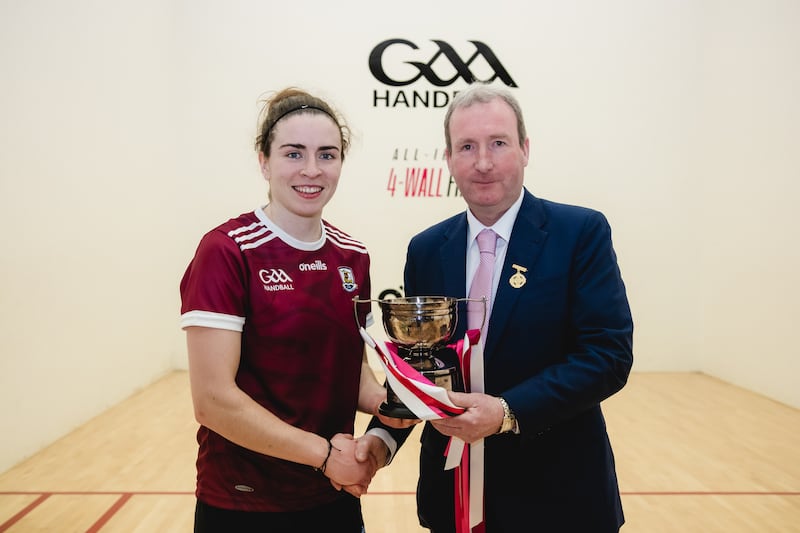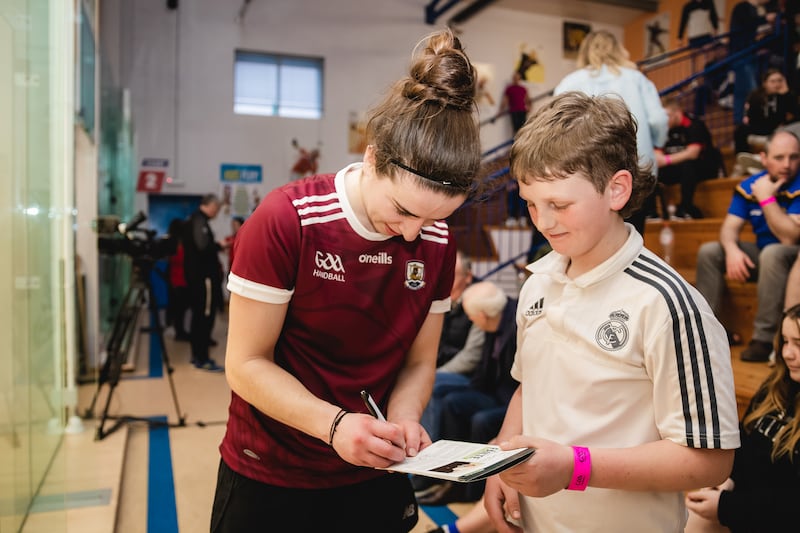When Ciana Ní Churraoin accepted the offer of a handball scholarship to Minnesota State University in Mankato, 80 miles from Minneapolis, in 2018, she sought advice about where she should stay.
As a master’s student, the freshman high jinks weren’t going to be for the Galway woman, so she pitched up just off campus, sharing an apartment with a fellow player. Five minutes’ walk away were four pristine courts. It was there that the plans for the most extraordinary ambush in Irish sport so far this year were laid.
As soon as she landed, Ní Churraoin got to work with her American coach, Mike Wells. They broke down her technique, dismantled parts of her game and rebuilt it, stronger and more functional. At weekends, she travelled coast to coast, on the pro tour, living the dream.
“I was in third year in Limerick, I studied PE and Irish, when Mike Wells reached out to me,” she recalled this week, in the wake of her maiden Irish senior singles title.
Inside Gaelic Games: The weekly GAA newsletter from The Irish Times
Lee Chin primed for another Wexford summer after wintering well in Australia
Darragh Ó Sé: Cork aren’t good enough to challenge Kerry and they don’t even seem angry about it
Seán Moran: Hurling championship appears to be the gift that keeps on giving, but enjoy it while you can
“I had travelled to a good few of the pro stops and I had been thinking it would be amazing to spend a full year out there, committing to playing in all those competitions.
“I learned so much. There are many parts of my game that I have brought from the US and things that I’ve continued to work on. I was there for two years but a lot of things we’ve talked about and worked on have only really come to the fore in my game in the last couple of months.”
In advance of last weekend’s GAA handball singles festival in Co Cavan, a fan site ran a series of polls, asking followers to call the various finals.
Most were close but there was one outlier – in the ladies’ senior singles, defending champion Catriona Casey gathered 95 per cent of the vote. Casey, 29, gunning for her seventh title, had been on a sensational run.

Last month, she cruised to victory at a pro stop in Texas, prompting top American promoter Dave Vincent to post online that “there is no other more celebrated professional handball player in our history”.
The consensus was that the All-Irelands would be merely a coronation for the Cork star, especially with her leading rival, Limerick’s Martina McMahon, out injured.
And then, last Sunday, Casey walked into a haymaker. Upsets tend to be relatively rare in handball, where, yes, the shot-making margins are fine but there are less variables than some sports. Casey being beaten seemed unthinkable. But Ní Churraoin, who picked up her qualification in Sport and Exercise Psychology in the States, thought differently – literally.
“I 100 per cent think that my background in psychology has helped me. Compared to the person I was going into my studies, my whole mind has evolved in terms of how I think about everything, on and off the court.
“I would have been a bag of nerves if this had happened before. But I kept the mindset that I had going into every game this season.
“Focus on what helps me perform. Take one point at a time. Even things as simple as focusing on my breathing between each serve, taking a moment. ‘All I have to do is focus on this serve’.
“Keeping it as simple as I possibly could. That’s something I would have found really difficult to do before, whereas on Sunday, I wasn’t thinking ‘this is my first All-Ireland final’, I was thinking ‘let’s do what I do to perform’. And if you can do that, you will more than likely get the result.”
Ní Churaoin describes her style of play as “offensive” and talks about a “controlled aggression”.

“I’m also calm and collected. I don’t react to much.” These are choices, she says, learned behaviour since her hot-headed younger days.
All of those traits were needed in the biggest match of her life. In game one, she came out shooting, winning 21-12. She rode her momentum to a 7-1 lead in game two before Casey came back and when the Cork woman closed it out 21-19, a familiar pattern – underdog plays above themselves, champion weathers the storm and closes it out – seemed to be stitching itself to proceedings.
And then, Ní Churraoin did that rare thing. She showed no fear of winning, kicked on and ran out an 11-3 winner in the tiebreaker.
This wasn’t just a first All-Ireland senior singles success, either. Conquering a generational player like Casey marked this out as spectacular because while the standard of women’s handball has never been as high, the field deeper than ever, the top two have had a stranglehold.
Casey and McMahon’s fierce rivalry had seen them reach a level all of their own and their very names on a drawsheet seemed to spook the others. When the opportunity came, Ní Churraoin railed against such thinking. Control, aggression. Not a step back.
“Obviously Catriona Casey is a very talented player and she has worked hard to win all she has won. And I think, definitely, if you’re consistently losing to a player, that can be something that you think about.
“I had never beaten Catriona before Sunday but something that I guess I’m quite proud of about myself is that I truly believe when I go into the court, no matter who I’m playing, that I can be successful. Obviously I can’t speak for other players if that is their experience.
“I can see that it could be easy to focus on ‘oh, I’ve never beaten this person’ or ‘most people think that I won’t win’, that can get you down. But in a way, that also takes away the pressure – nobody expects me to win, I can just go in there and perform.”

Her training is tailored to her style. At 26, she is no longer a slave to long hours of technical practice alone in the court. She attends a crossfit gym in Moycullen and hits the alley a few times a week, usually sparring against local male players. In recent months, she has been charting her sometimes slapstick attempts at learning to handstand on Instagram. Enjoying it is the key.
“I really enjoy those challenging workouts, afterwards I’m absolutely dead. Some people might say it’s not specifically handball training but it builds up your fitness and at the end you can say ‘that was really hard and I still kept going’.
“So there are a lot of advantages to it. And the more I enjoy my training, the easier it is to keep going.
“There’s that side of it, being super-fit and feeling I can push through the games and then stuff like learning handstands, learning different skills, that also adds to the enjoyment going to the gym. I find that takes the pressure off always making progress in handball – I’m trying to progress in a whole range of things.”
Her great passion is promotion of the Irish language. People’s opinions on it, she says, “can get me going”. She believes everyone should be comfortable engaging, giving it a go. There is so much goodwill there but a lot more can be done – just like her chosen sport, really.
The long-delayed National Centre at Croke Park will soon finally open its doors which will give the top players a fitting stage. A link-up with the GAA’s Coaching and Games Department also promises much but Covid took its toll and handball remains vulnerable.
“It’s easy for myself to be on a high about everything now but there’s definitely a lot of progress that can be made in terms of promoting the game. But there are also a lot of opportunities for improvement which is a good thing as well.
“This is an amazing sport and there are many, many ways that we can keep pushing it on nationally to get it to be seen on a bigger scale and also to make it more exciting for young players to want to keep playing and get to the stage where they are competing in a senior final, to see that that is an amazing to do. There is a lot of room for improvement.
“You want the All-Ireland to feel like, ‘wow, this is where I want to be’ and for young kids to say ‘that’s my goal, I want to be in there in 10 or 15 years playing this game’.”














